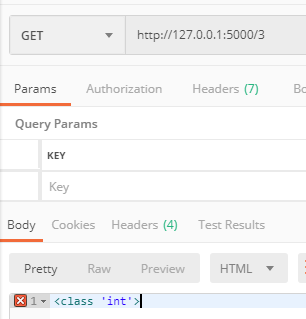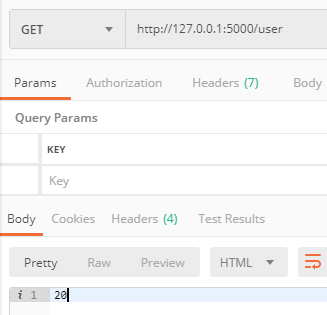1.一般
http://127.0.0.1:5000/meng
@app.route('/hello') def hello_world(): return 'heeee'
2.类型转换
默认接受转成string类型
http://127.0.0.1:5000/3
@app.route('/<int:count>') def index(user): return str(type(user))

可转换的其他类型
|
|
(缺省值) 接受任何不包含斜杠的文本 |
|
|
接受正整数 |
|
|
接受正浮点数 |
|
|
类似 |
|
|
接受 UUID 字符串 |
3.传递多个值
@app.route('/<user>/<int:count>') def index(user,count): return count
4.默认值
@app.route('/user', defaults={'count': 20}) @app.route('/user/<int:count>') def index(count): return str(count)

5.参数限制
@app.route('/<any(blue,red):color>') def index(color): print(color) return color
http://127.0.0.1:5000/red 如果url里对应的位置,不是blue或red就会报404
6.请求方式
from flask import Flask,request app = Flask(__name__) @app.route('/<user>', methods=['get','post','put']) def index(user): print(request.method) if request.method == 'GET': #要大写 return user + 'Get' elif request.method == 'POST': return user + 'Post' else: return user + request.method
| 1 |
GET 以未加密的形式将数据发送到服务器。最常见的方法。 |
| 2 |
HEAD 和GET方法相同,但没有响应体。 |
| 3 |
POST 用于将HTML表单数据发送到服务器。POST方法接收的数据不由服务器缓存。 |
| 4 |
PUT 用上传的内容替换目标资源的所有当前表示。 |
| 5 |
DELETE 删除由URL给出的目标资源的所有当前表示。 |
7.末尾是否加 /
@app.route('/hello/')
加了/的话
都能访问
8. key-value方式传值
http://127.0.0.1:5000?user=meng
from flask import Flask,request app = Flask(__name__) @app.route('/') def index(): user = request.args.get("user") return user